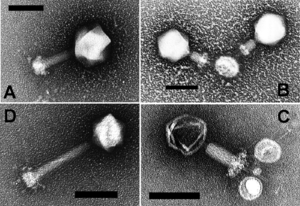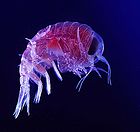- Marine bacteriophage
-
 Electron micrograph of negative-stained Prochlorococcusmyoviruses
Electron micrograph of negative-stained Prochlorococcusmyoviruses
Marine bacteriophages or marine phages are viruses that live as obligate parasitic agents in marine bacteria such as cyanobacteria.[1] Their existence was discovered through electron microscopy and epifluorescence microscopy of ecological water samples, and later through metagenomic sampling of uncultured viral samples.[1][2] The tailed bacteriophages appear to dominate marine ecosystems in number and diversity of organisms.[1]
Bacteriophages, viruses that are parasitic on bacteria, were first discovered in the early twentieth century. Scientists today consider that their importance in ecosystems, particularly marine ecosystems, has been underestimated, leading to these infectious agents being poorly investigated and their numbers and species biodiversity being greatly under reported.[3]
Contents
Marine phages
Marine phages, although microscopic and essentially unnoticed by scientists until recently, appear to be the most abundant and diverse form of DNA replicating agent on the planet. There are approximately 4x1030 phage in oceans or 5x107 per millilitre.[4] They appear to influence biogeochemical cycles globally, provide and regulate microbial biodiversity, cycle carbon through marine food webs, and are essential in preventing bacterial population explosions.[5] Scientists are exploring the potential of marine cyanophages to be used to prevent or reverse eutrophication.
In sediments
Marine bacteriophage form an important part of deep sea ecosystems. There are between 5x1012 and 1x1013 phage per square metre in deep sea sediments and their abundance closely correlates with the number of prokaryotes found in the sediments. They are responsible for the death of 80% of the prokaryotes found in the sediments, and almost all of these deaths are caused by cell lysis (bursting). They therefore play an important part in shifting nutrients from living forms into dissolved organic matter and detritus. This explains the high rate of nutrient turnover in deep sea sediments. The release of nutrients from infected bacteria stimulates the growth of uninfected bacteria and then these also become infected. Because of the importance of deep sea sediments in biogeochemical cycles, marine bacteriophage must influence the carbon, nitrogen and phosphorus cycles, but the exact influences are currently not understood.[4]
Carbon cycle
Marine viruses may play an important role in the carbon cycle by increasing the efficiency of the biological pump. The argument is that lysis releases unstable compounds, such as amino acids and nucleic acids, which tend to be recycled near the surface, whereas more indigestible carbon-rich material, such as that found in cell walls, is probably exported to deeper waters. Thus, the material that is exported to deeper waters by the 'viral shunt' is probably more carbon rich than the material from which it was derived. This would increase the efficiency of the biological pump. [6]
References
- ^ a b c Mann, NH (2005-05-17). [7885/3/5/pdf/10.1371_journal.pbio.0030182-S.pdf "The Third Age of Phage"]. PloS Biol (United States: Public Library of Science) 3 (5): 753–755. doi:10.1371/journal.pbio.0030182. PMC 1110918. PMID 15884981. 7885/3/5/pdf/10.1371_journal.pbio.0030182-S.pdf. Retrieved 2008-03-31.
- ^ Wommack, K. Eric; Russell T. Hill, Terri A. Muller, and Rita R. Colwell (April 1996). "Effects of sunlight on bacteriophage viability and structure". Applied and Environmental Microbiology (United States of America: American Society for Microbiology) 62 (4): 1336–1341. PMC 167899. PMID 8919794. http://www.pubmedcentral.nih.gov/articlerender.fcgi?tool=pmcentrez&artid=167899.
- ^ Kellogg, CA; JB Rose, SC Jiang, and JM Thurmond, and JH Paul (1995). "Genetic diversity of related vibriophages isolated from marine environments around Florida and Hawaii, USA". Marine Ecology Progress Series (Germany: Inter-Research Science Center) 120 (1–3): 89–98. doi:10.3354/meps120089.
- ^ a b Danovaro, Roberto; Antonio Dell'Anno1, Cinzia Corinaldesi1, Mirko Magagnini, Rachel Noble, Christian Tamburini & Markus Weinbauer (2008-08-28). "Major viral impact on the functioning of benthic deep-sea ecosystems". Nature 454 (7208): 1084–1087. doi:10.1038/nature07268. PMID 18756250. http://www.nature.com/nature/journal/v454/n7208/abs/nature07268.html. Retrieved 2009-05-03.
- ^ Waldor, M; D Friedman S Adhya, editors (2005). Phages: their role in bacterial pathogenesis and biotechnology. Washington DC: ASM Press. pp. 450. ISBN 978-1555813079.
- ^ Suttle CA. Marine viruses—major players in the global ecosystem. Nature Reviews. Microbiology. 2007;5(10):801–12. doi:10.1038/nrmicro1750. PMID 17853907.
Aquatic ecosystems – general and freshwater components General - Aquatic ecosystems
- Acoustic ecology
- Agent-based models
- Algal bloom
- Anoxic waters
- Aquatic adaptation
- Aquatic animals
- Aquatic biodiversity research
- Aquatic biomonitoring
- Aquatic insects
- Aquatic layers
- Aquatic mammals
- Aquatic plants
- Aquatic predation
- Aquatic respiration
- Aquatic science
- Aquatic toxicology
- Benthos
- Bioluminescence
- Biomass
- Cascade effect
- Colored dissolved organic matter
- Dead zone
- Ecohydrology
- Eutrophication
- Fisheries science
- Food chain
- Food web
- GIS and aquatic science
- Hydrobiology
- Hypoxia
- Isotope analysis
- Microbial ecology
- Microbial food web
- Microbial loop
- Nekton
- Neuston
- Particle
- Photic zone
- Phytoplankton
- Plankton
- Productivity
- Ramsar Convention
- Schooling
- Sediment trap
- Siltation
- Spawning
- Substrate
- Thermal pollution
- Trophic level
- Underwater camouflage and mimicry
- Water column
- Zooplankton
- More...

Freshwater - Freshwater ecosystems
- Brackish marsh
- Freshwater biology
- Freshwater biomes
- Freshwater fish
- Freshwater marsh
- Freshwater swamp forest
- Hyporheic zone
- Lake ecosystems
- Landscape limnology
- Limnology
- Lake stratification
- Macrophyte
- Pond
- Fish pond
- Rheotaxis
- River ecosystems
- Stream bed
- Stream pool
- Trophic state index
- Upland and lowland
- Water garden
- Wetland
- Environmental quality
- More...
Ecoregions - Freshwater ecoregions
- List of freshwater ecoregions
- Marine ecoregions
- List of marine ecoregions
- Ecology of the Everglades
- Ecology of the San Francisco Estuary
- Ecosystem of the North Pacific Subtropical Gyre
- Freshwater ecology of Maharashtra
Aquatic ecosystems – marine components Marine 
Marine
life forms- Census of Marine Life
- Coastal fish
- Coral reef fish
- Deep sea communities
- Deep sea creature
- Deep sea fish
- Deep water corals
- Demersal fish
- Marine bacteriophage
- Marine invertebrates
- Marine larval ecology
- Marine mammal
- Marine reptile
- Marine vertebrate
- Paradox of the plankton
- Pelagic fish
- Seabird
- Seashore wildlife
- Wild fisheries
Marine
habitats- Bay mud
- Black smokers
- Coastal biogeomorphology
- Cold seeps
- Coral reefs
- Davidson Seamount
- Estuaries
- Intertidal ecology
- Intertidal wetland
- Kelp forests
- Hydrothermal vent
- Lagoons
- Mangroves
- Marine biomes
- Marine habitats
- Mudflat
- Rocky shores
- Salt marshes
- Seagrass meadows
- Sponge reefs
- Tide pools
Issues - Ecological values of mangrove
- Fisheries and climate change
- HERMIONE
- Marine conservation
- Marine conservation activism
- Marine pollution
- Marine Protected Area
Categories:- Marine biology
- Bacteriophages
Wikimedia Foundation. 2010.


